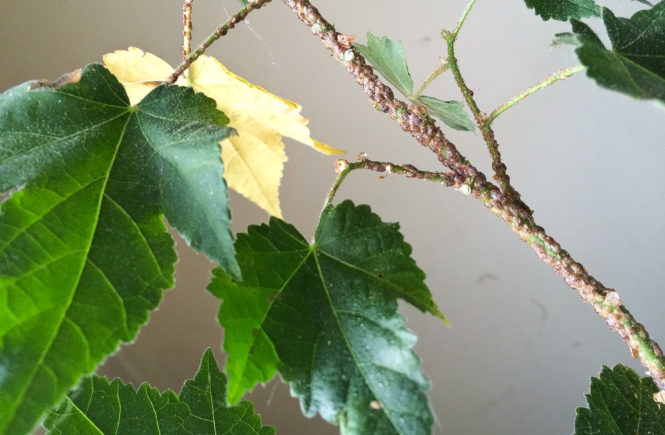For the last few months I’ve been battling scale on an large indoor-wintering abutilon, or Flowering Maple. I’d been occasionally picking the scale off by hand, or with a microfiber cloth, (which works quite well) and I was (sort of) keeping them at bay. I’m a pretty experienced scale squisher, and I thought I had it under control.
My plan was to douse the plant in the bathtub with some vigorous blasts of water and insecticidal soap to completely get rid of the critters, but I kept putting it off, there were other things to do, like….taxes? Walking the dog? I hesitated also, as because of its size, carrying the plant down the hall into the bathtub would have been quite a production and I was worried that the move might dislodge some of the scale, spreading it about.
I’ve been on “scale watch” all winter and every now and then I’d glance over at it and think, oh, they’re getting bad again, I better do something. But I didn’t. In spite of the scale, my abutilon was growing pretty luxuriously. I’ve been training it as a standard and it was practically a tree in my living room, growing out about 4 feet in all directions. Trouble was I didn’t notice that the scale was also multiplying at a furious rate, and today I saw that every branch was
covered in various stages of scale
growth, from little green bumps to mature brown armoured versions. It was truly a “dithgusting thpectacle’. (Please rea
d that phrase in a Sylvester the cat voice)
But the plot thickens: Over the past few weeks I kept noticing that another plant pot and a pile of books sitting underneath my abutilon were becoming mysteriously speckled with a shiny substance and I couldn’t figure out what was causing it. Well, lo and behold after a trip to Google, I learned that the mysterious speckles were dropping from my scale insects. As they chomp on the plant and suck out its sap, they simultaneously excrete a honeydew. Missouri Botanical Garden explains:
Honeydew is the insects’ excrement consisting of partially digested sap and may coat the floor and other objects beneath the plant as it spatters down from above. A sticky floor beneath a susceptible plant is a telltale sign that infestation is underway.
Eeeek! Shudder. That was the last straw. Drastic measures were called for. Too late for insecticidal soap. Out came the pruners and a garbage bag. I pruned every leafy, scaly branch off, and now have just a two foot stub of woody stems. The scale insects aren
‘t strong enough to penetrate the woody parts of the plant so they were scale-free. Also, thankfully the dropped honeydew is water soluble and was easy to remove from the book covers with a damp microfibre cloth. And once the abutilon goes back outdoors I’m sure will be back to its old self, sans scale. But I’ve learned my lesson. I’ll never let a scale infestation get as bad as that again.





1 comment
I’ve often done that – seen the problem, contemplated the problem, knew that I should resolve the problem, and then delude myself into thinking that it won’t get any worse and dealing with it can wait as other things are more urgent. I hope that your abutilon enjoys being scale free and rewards you with lots of new growth this season 🙂